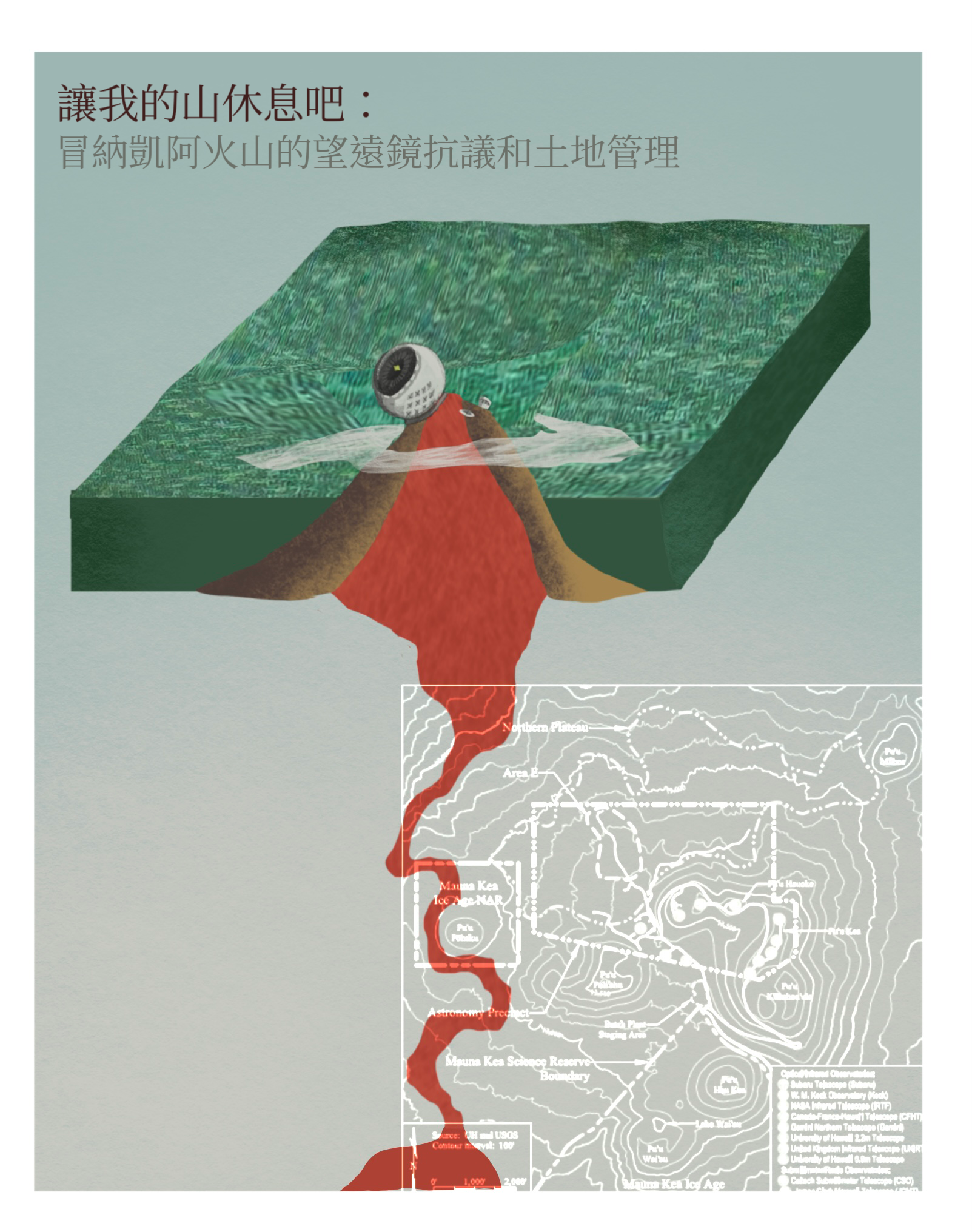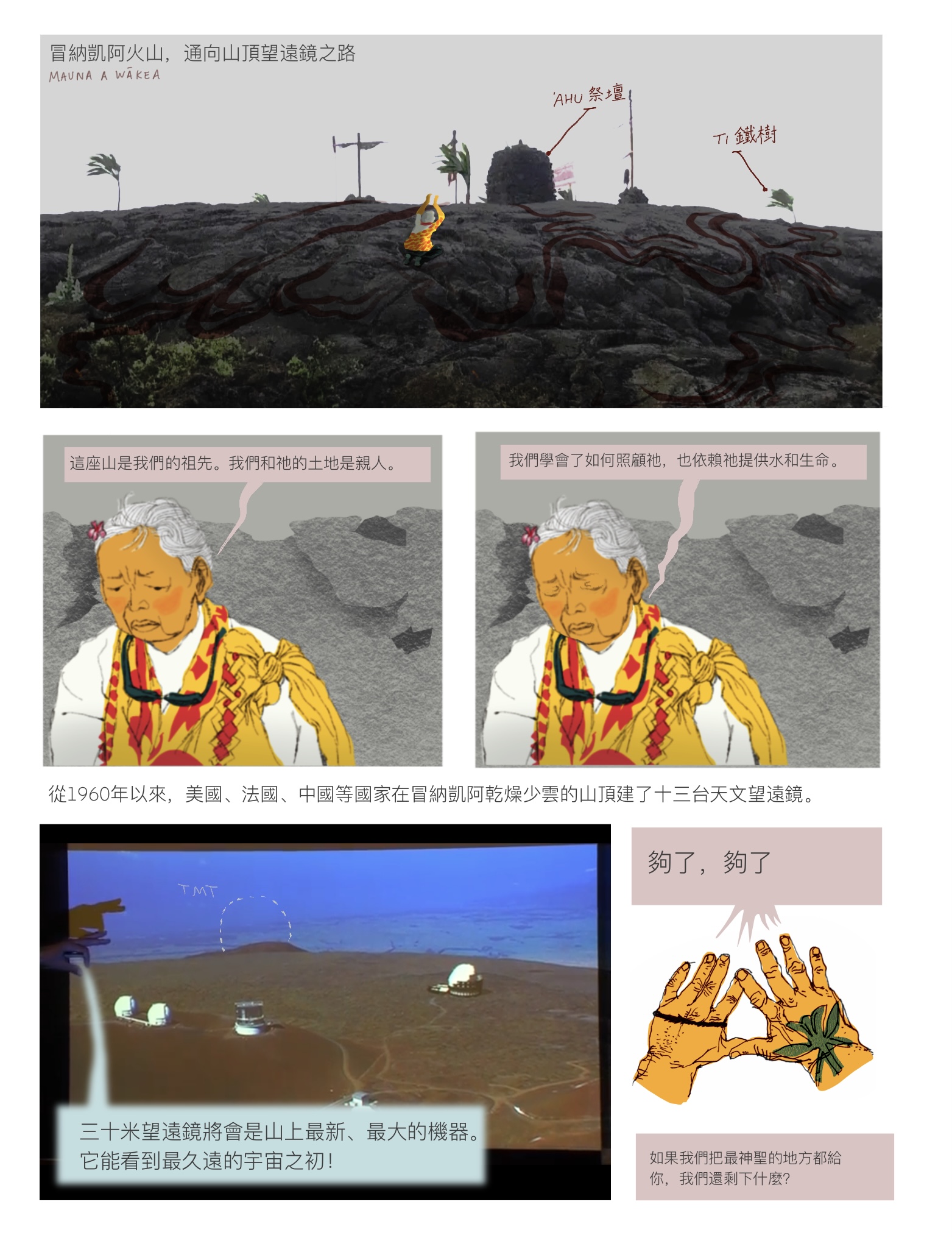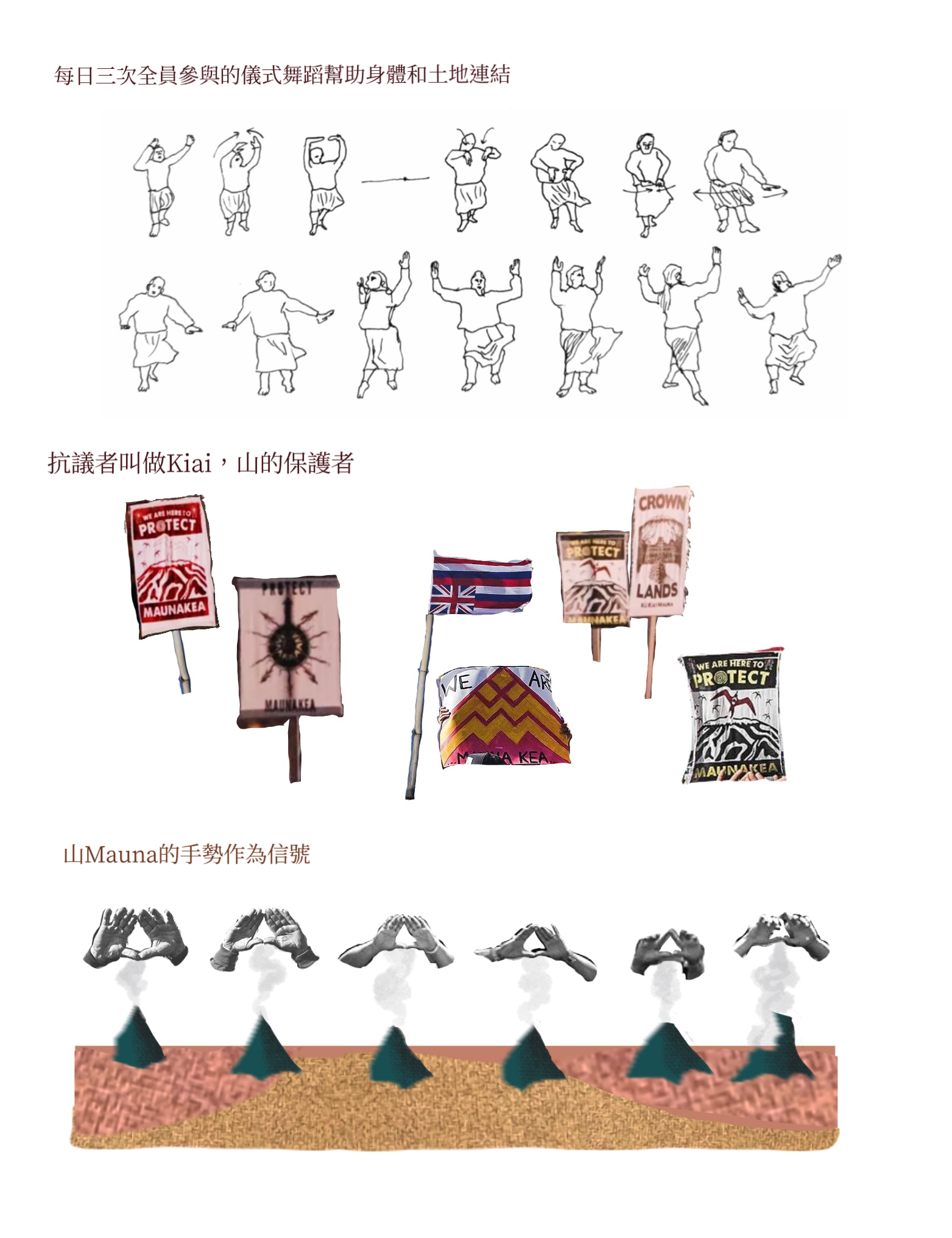context
There was an open call for proposals on chinese language nonfiction comic by the Frontline Fellowship and the Slow Works publishing house. I found their application and related compilations to be really exciting so I spent around 20 hours generating ideas about stories I want to tell in the graphic format and then implementing one of them, on the Hawaii telescope protests that I kept returning to in my head from 2015-2019-now.
Pages
Over the course of the week preparing, I collected image resources and drew on printer paper. Then 4 hours before the deadline I assembled them on drawing pad.



proposal
“Theme”: I plan to write a nonfictional zine about the controversy over the Thirty Meter Telescope (TMT) on the Mauna Kea volcano in Hawaii. Mauna Kea is a dormant volcano on the Big Island of Hawaii that is considered sacred in Native Hawaiian culture. Due to its high altitude, dry climate and extremely low light pollution, it is one of the world’s most privileged astronomical observation sites. After a tsunami devastated the city of Hilo on the island of Hawaii in 1960, the Hawaii state government granted the University of Hawaii a 65-year lease and began recruiting astronomers to develop the observatory. They operate the Mauna Kea Peak area as a science reserve. Environmentalists, Indigenous peoples, and other groups began to protest, arguing that the sacred mountain was desecrated by construction and pollution. In 2014, the Thirty Meter Telescope (TMT) project announced plans to build a new generation observatory in maunakea. In 2015, the indigenous group Kia’i was stationed at the foot of the hill to stop the construction of the TMT. Several Hawaiian elders were arrested for obstructing construction. In 2019-20, protests expanded. From 2023 to 2028, telescope managers and core protesters began to try to establish a future indigenous and government-based model of shared land management.
This zine will present: (1) the current state of protest and the perspectives and interests of all parties; (2) the historical background of Hawaii’s land rights, astronomical industry, and cultural revival; and (3) land rights, land management and scientific power structure from a global perspective.
“Why is this topic Important, scarce, and must be written for you”: I immigrated to Oahu, Hawaii, with my family when I was twelve. In high school, I was obsessed with astronomy and often listened to astronauts and scientists looking for earth-like planets in the astronomy department of the University of Hawaii share their explorations. It was then that I first learned about the Thirty-Meter Telescope (TMT) project, and the protests that puzzled many astronomers at the time. In 2019, I participated in the Kia’i protest camp for two days in the company of my college classmates, who have more experience in their own cultures and movements. I felt the anger and love of the protesters during dances, ceremonies, temporary political history classes and volunteer activities. But I can’t fully empathize with the protesters’ feelings about protecting their homeland like my fellow friends, because I still want science to coexist with culture in a way that respects and helps local lands. Gradually, confusion turned into curiosity: I wanted to explore, as a semi-outsider between astronomy and the local population: what are the needs and histories of the parties behind the conflict? Is there a future where science and community can co-govern land and knowledge?
Much of what I wrote in this image zine, unknown to me during my time in Hawaii, was driven by ambivalence to learn about the history. I didn’t even know that there were 50 years of protest history before I first heard about the TMT protests in 2018; I also don’t know that after my visit to the protest camp in 2019, the camp was evacuated and the land management rights of Mauna Kea began a five-year transfer period; Not to mention the cultural renaissance that Native Hawaiians experienced in the 1960s-70s. I decided to translate these questions and exploratory research into an iconographic zine, because there is a wealth of first-hand information on the topic – documents, photographs – that tell a story in itself. I hope that this little book will share with you Chinese-speaking readers what I have seen about Hawaii’s land issues and telescope controversy, and that it will also remind you of similar situations outside of Hawaii, the tension between science and land management and local communities around the world. For example, China faced similar problems with the relocation of villages and cultural impacts during the construction of the 500-meter aperture spherical radio telescope (FAST). Taiwan’s forest management system, which originated during the Japanese colonial period, also involves disputes over indigenous land rights.
“Plan”: The survey will be conducted conducted in January-February. First-hand information: - 1:1 interviews online: Representatives of protectors (Kia’i, Royal Order, Kapu practitioners), astronomical community (TMT project team, Hawaii Astronomical Institute, University of Hawaii astronomy professor I know), government stakeholders (Ministry of Lands and Natural Resources, Mauna Kea Authority), key figures involved in the transition to the new management model (MKSOA). - Adopt the Ritchie method of oral history lessons. Secondary sources: Collected data on the Hawaiian cultural revival in the 1960s and 80s, documents on land administration transitions, and two similar global case studies. Creation will take 1-2 months, including iterations. The final format is a 20-page manga.
- 3 pages: Opening Scene/Personal Introduction (including my personal experiences in the protest camp and the Institute of Astronomy)
- 3 pages: Astronomical Science Perspectives and Needs (introducing the astronomical value of Maunakya and the scientific objectives of TMT).
- 5 pages: Hawaiian (Kanaka Maoli) Cultural Perspectives and Demands (exploring the cultural significance and historical trauma of Maunakya).
- 3 pages: current Situation and Management Change (documenting the development of the new condominium model). Page 4: Future Possibilities and Global Perspectives (exploring solutions to similar conflicts).
Resource Requirements:
- Funding: $400 (basic food and housing to support my full-time creation)
- Least Resourced: Professional editorial guidance and feedback to improve scripting and drawing expression
提案
「主题」: 我计划创作一篇关于夏威夷冒纳克亚(Mauna Kea)火山上的”三十米望远镜”(TMT)争议的非虚构zine。冒纳克亚是夏威夷大岛上的一座休眠火山,在夏威夷原住民文化中被视为神圣之地。因其高海拔、干燥气候和极低的光污染,它是世界上最优越的天文观测地点之一。1960年一场海啸摧毁夏威夷岛希洛市后,夏威夷州政府授予夏威夷大学65年租约,开始招募天文学家在此发展天文台。他们将冒纳克亚山顶区域作为科学保护区运营。环保主义者、原住民和其他团体开始抗议,认为神圣之山被施工和污染亵渎。2014年三十米望远镜(TMT)项目宣布计划在冒纳克亚建造新一代天文台。2015年,原住民组织Kia’i驻扎山脚阻止TMT建设。多名夏威夷长者由于阻挡施工被逮捕。2019-20年,抗议扩大。2023到2028年,望远镜管理者和核心抗议者开始尝试建立未来的原住民文化和政府、科学的共同土地管理模式。这本zine将呈现:(1)抗议现状及各方视角与利益;(2)夏威夷土地权利、天文产业与文化复兴的历史背景;(3)全球视角下的土地权益、土地管理与科学权力结构。
「重要、稀缺、非写不可」: 我在十二岁时随家人移民到夏威夷欧胡岛。高中时期,我痴迷于天文,经常在夏威夷大学的天文系聆听宇航员和寻找类地行星的科学家分享他们的探索。也是在那时,我初次了解到三十米望远镜(TMT)计划,以及当时令许多天文学家不解的抗议活动。2019年,我在更有民间组织经验的科索沃大学同学的陪同下参与Kia’i抗议营地两天,在舞蹈、仪式、临时政治历史课程和志愿活动中,感受到抗议者的愤怒与热爱。但我不能像同行的科索沃朋友那样全然与抗议者共情保护家园的感受,因为我仍然希望科学能以尊重和互助当地土地的方式与文化共存。逐渐,困惑变成好奇:我想作为一个处于天文和当地居民之间的半局外人,探索:冲突背后各方的需求和历史是什么?未来有科学和社区可以共同治理土地和知识的可能性吗? 我在这篇图像zine里写的大部分内容,在我居住夏威夷期间都不知道,是矛盾情绪驱使我逐渐学习到这些历史。我甚至不知道在2018年第一次听说TMT抗议之前,已有长达50年的抗议历史;也不知道在我2019年拜访抗议营地之后,营地撤离,冒纳凯亚火山的土地管理权开始了为期五年的转交期;更不知道夏威夷原住民在1960-70年代经历了文化复兴。我决定将这些问题和探索研究转化为一本图像zine,因为这个话题有丰富的第一手资料——文件、照片——这些材料本身就能讲述故事。我希望这本小书能向华语读者的你分享我看见的夏威夷土地问题和望远镜争议,也能让你联想到夏威夷之外相似的情况,在全球各地科学与土地管理和当地社区的张力。比如中国在建设五百米口径球面射电望远镜(FAST)时也面临了类似的迁村和文化影响问题;台湾源自日本殖民时期的森林管理系统同样涉及原住民土地权益争议。
「计划」: 调研1-2月。一手资料: 线上进行1:1采访: 保护者代表(Kia’i、Royal Order、Kapu修行者)、天文界人士(TMT项目组、夏威夷天文研究所、我认识的夏威夷大学天文教授)、政府相关人员(土地与自然资源部、冒纳克亚管理局)、参与新管理模式过渡的关键人物(MKSOA)。采用口述历史课的Ritchie方法。二手资料:收集1960-80年代夏威夷文化复兴资料、土地管理转型文件,以及两例类似全球案例的比较研究资料。 创作1-2月,包括迭代。最终格式是20页页漫。3页:开场场景/个人引入(包括我在抗议营地和天文研究所的亲身经历)3页:天文科学视角与需求(介绍冒纳克亚的天文价值及TMT的科学目标)。5页:原住民文化视角与诉求(探索冒纳克亚的文化意义及历史伤痛)。 3页:当前状况与管理变革(记录新的共管模式发展)。4页:未来可能性与全球视角(探讨类似冲突的解决方案)。
「所需资源」:
- 资金: 400美金(支持我全职创作的基本吃住)
- 最缺乏资源: 专业编辑指导和反馈,以提高脚本和绘画表达水准
References/research
reference interviews and primary sources参考采访(多个):链接、Mauna Kea TMT protest readings
reference images 参考视觉(多个):链接
Related
- 降落伞科学-问题和解法 (Parachute Science-Problem and Solutions): the Mauna Kea TMT protests, in my current understanding, boil down to science using land that was taken in power dispute with local community. this is a form of parachute science because the land is taken but the astronomy does not pay or benefit the residents.
- How to herd sheep: for Navajo families on Black Mesa AZ, they also face the issue of land that they need for a way of life (herding, water) is taken away for corporate or government use.
- Rere, the funnel view of spirits in painters: when I told rere about my sadness for not having a special shamanic god that makes me uniquely demanded to serve as an artist, no gift, we discussed the tibetan view that every person is a funnel, and this openness or throughput is tuned by several things — the input, the filter. you can, anyone can, cultivate the structure to receive the input better. for me, experiencing and learning from people and beings in the world is the input that i am actively attending to, and even if i don’t have deities to demand or help me with the delivery, i can born a just so baby that still nonetheless gives me and some others a tunnel funnel to see it.
Feedback from the fellowship
Editor feedback:
- Proposal: “the theme and motivation is clear and interesting. the theme of science & technology vs humanities, nature and development is a good one and there’s not many comics about this topic. the author’s personal motivation offers intimate perspectives. the story relates to global indigenous land movements. the specialness of hawaiian volcanic landscape can be good visuals.”
- Sample pages: “visual completion and comic frame organization need to improve. the collage style is possible but currently it’s too fragmented, looking like a PPT. the script has too many things it wants to say. the unique perspective and the need to use comic instead of text is not clear.”
My reaction:
- I would like to improve my storyboarding and visual completion abilities!
- I am glad they find this topic interesting too!
企划
- 此案是個很不錯的選題,類似的命題在過往到現在都存在,科技與人文、自然與發展,但相對少見漫畫以此為主題。申請者自身的動機亦強烈,兒時著迷於天文,但又同時是生活在該地的生活者,拋出的提問更能同時兼具兩個視角。
- 創作者與冒納凱阿火山望遠鏡設置的爭議,因為創作者自小在夏威夷島上生活,有相當特殊的連帶的關係。也可以透過創作者對此爭議的介紹,聯想到世界各地的原住民土地運動之外,也有夏威夷當地的火山地景帶出的特殊性。 试绘稿
- 企圖太大,要講的事太多。但呈方式像 PPT 報告,不具漫畫閱讀可能。
- 以目前的腳本與試繪稿來看,申請者的分鏡與完稿技法仍需加強,拼貼也是圖像敘事的方式之一,但現在看起來還太過破碎。採訪與調研的方向還算清楚,但同時也要思考視覺呈現的計劃,這部分較為不足。
- 不過以目前的進度來說,看不出創作者自身特殊的觀點,以及是否一定得要透過漫畫釐清這個議題的必要性。
- 文字計畫和動機闡述很清楚,看起來也有很有趣的素材,但是對作者的圖像處理和漫畫分鏡能力有一些保留。